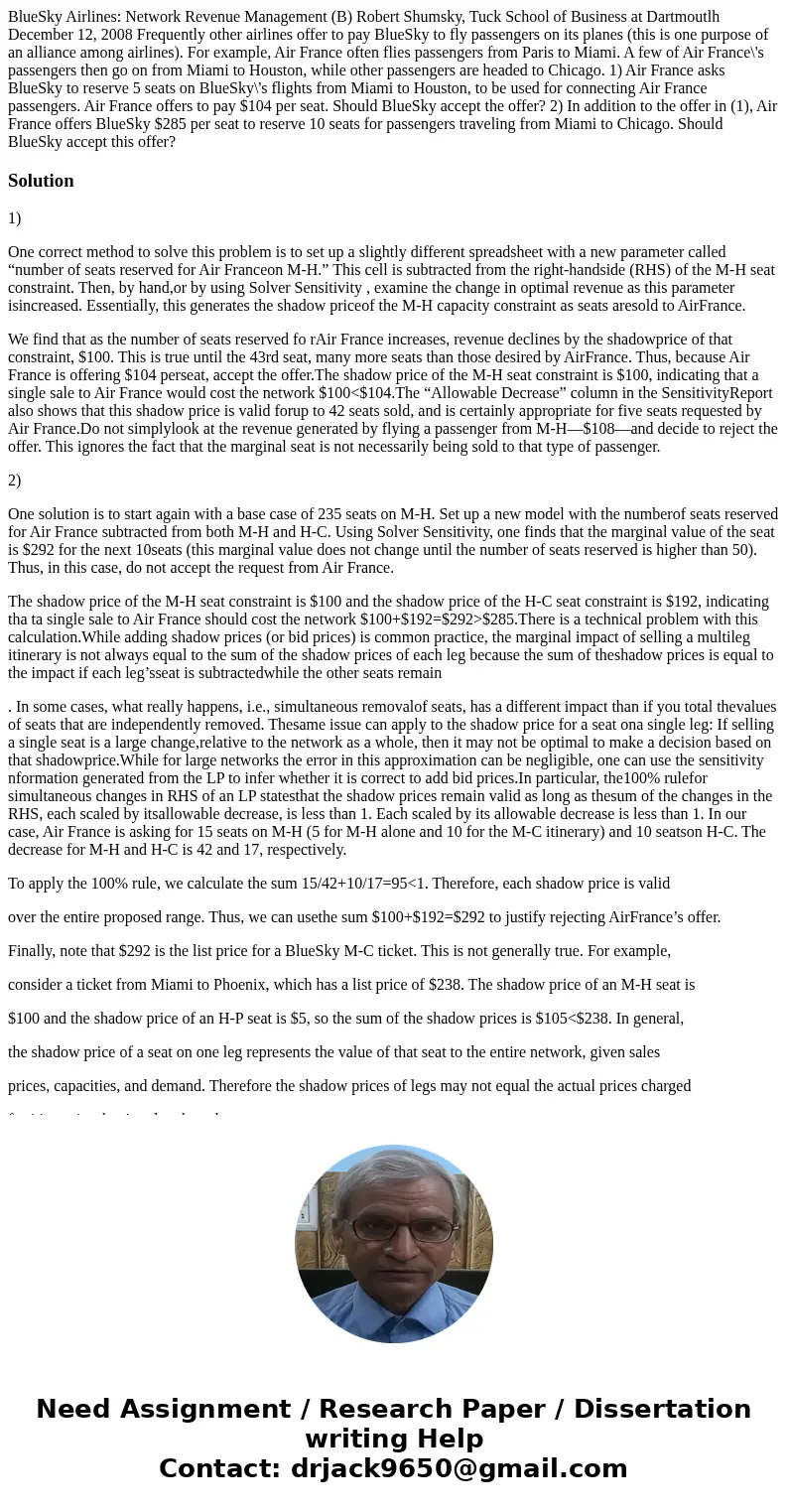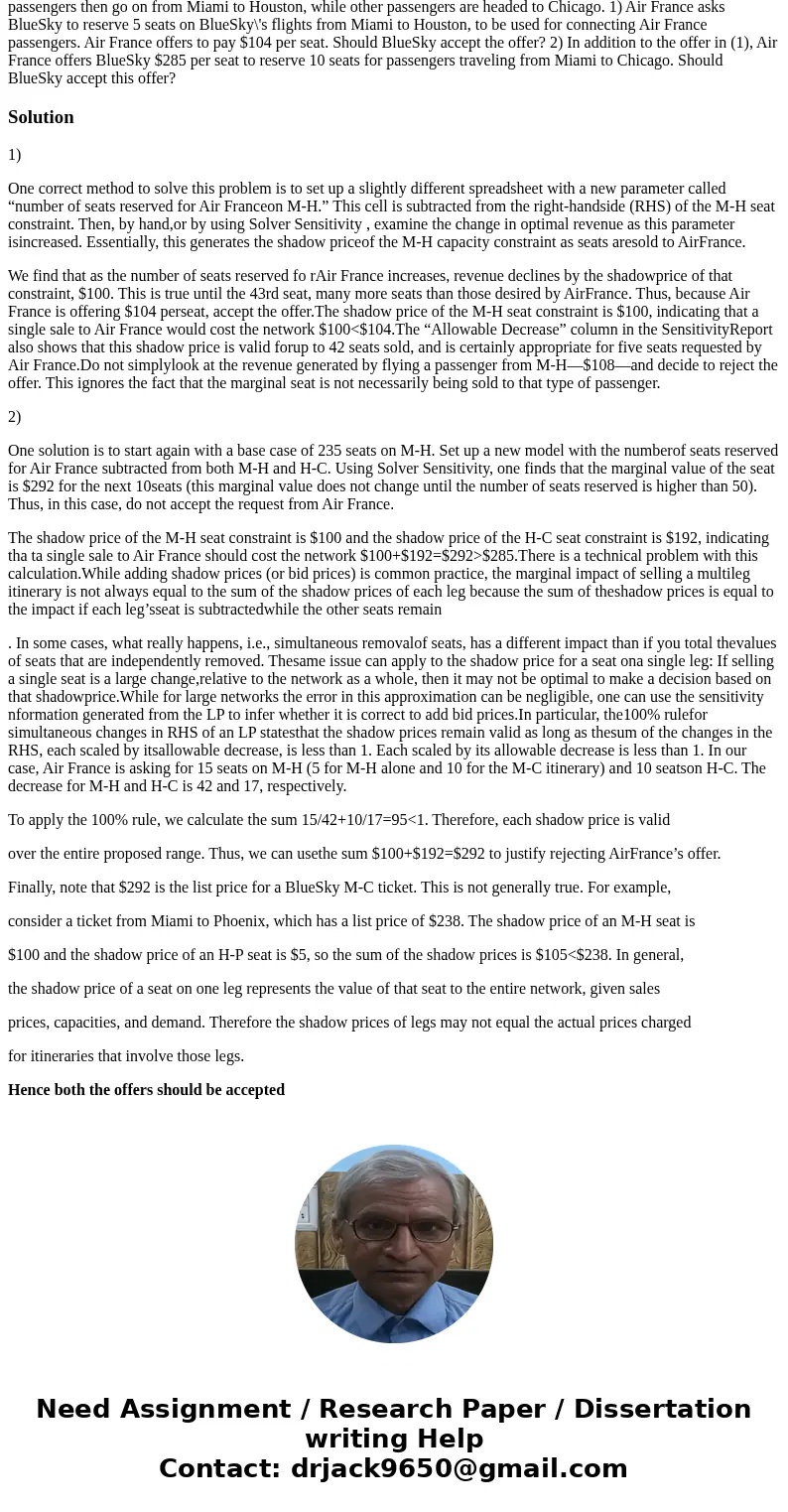BlueSky Airlines Network Revenue Management B Robert Shumsky
Solution
1)
One correct method to solve this problem is to set up a slightly different spreadsheet with a new parameter called “number of seats reserved for Air Franceon M-H.” This cell is subtracted from the right-handside (RHS) of the M-H seat constraint. Then, by hand,or by using Solver Sensitivity , examine the change in optimal revenue as this parameter isincreased. Essentially, this generates the shadow priceof the M-H capacity constraint as seats aresold to AirFrance.
We find that as the number of seats reserved fo rAir France increases, revenue declines by the shadowprice of that constraint, $100. This is true until the 43rd seat, many more seats than those desired by AirFrance. Thus, because Air France is offering $104 perseat, accept the offer.The shadow price of the M-H seat constraint is $100, indicating that a single sale to Air France would cost the network $100<$104.The “Allowable Decrease” column in the SensitivityReport also shows that this shadow price is valid forup to 42 seats sold, and is certainly appropriate for five seats requested by Air France.Do not simplylook at the revenue generated by flying a passenger from M-H—$108—and decide to reject the offer. This ignores the fact that the marginal seat is not necessarily being sold to that type of passenger.
2)
One solution is to start again with a base case of 235 seats on M-H. Set up a new model with the numberof seats reserved for Air France subtracted from both M-H and H-C. Using Solver Sensitivity, one finds that the marginal value of the seat is $292 for the next 10seats (this marginal value does not change until the number of seats reserved is higher than 50). Thus, in this case, do not accept the request from Air France.
The shadow price of the M-H seat constraint is $100 and the shadow price of the H-C seat constraint is $192, indicating tha ta single sale to Air France should cost the network $100+$192=$292>$285.There is a technical problem with this calculation.While adding shadow prices (or bid prices) is common practice, the marginal impact of selling a multileg itinerary is not always equal to the sum of the shadow prices of each leg because the sum of theshadow prices is equal to the impact if each leg’sseat is subtractedwhile the other seats remain
. In some cases, what really happens, i.e., simultaneous removalof seats, has a different impact than if you total thevalues of seats that are independently removed. Thesame issue can apply to the shadow price for a seat ona single leg: If selling a single seat is a large change,relative to the network as a whole, then it may not be optimal to make a decision based on that shadowprice.While for large networks the error in this approximation can be negligible, one can use the sensitivity nformation generated from the LP to infer whether it is correct to add bid prices.In particular, the100% rulefor simultaneous changes in RHS of an LP statesthat the shadow prices remain valid as long as thesum of the changes in the RHS, each scaled by itsallowable decrease, is less than 1. Each scaled by its allowable decrease is less than 1. In our case, Air France is asking for 15 seats on M-H (5 for M-H alone and 10 for the M-C itinerary) and 10 seatson H-C. The decrease for M-H and H-C is 42 and 17, respectively.
To apply the 100% rule, we calculate the sum 15/42+10/17=95<1. Therefore, each shadow price is valid
over the entire proposed range. Thus, we can usethe sum $100+$192=$292 to justify rejecting AirFrance’s offer.
Finally, note that $292 is the list price for a BlueSky M-C ticket. This is not generally true. For example,
consider a ticket from Miami to Phoenix, which has a list price of $238. The shadow price of an M-H seat is
$100 and the shadow price of an H-P seat is $5, so the sum of the shadow prices is $105<$238. In general,
the shadow price of a seat on one leg represents the value of that seat to the entire network, given sales
prices, capacities, and demand. Therefore the shadow prices of legs may not equal the actual prices charged
for itineraries that involve those legs.
Hence both the offers should be accepted


 Homework Sourse
Homework Sourse